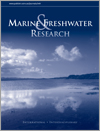Marine and Freshwater Research
Volume 74
Number 12 2023
Ecosystem management efforts are often challenged by a lack of integrated knowledge. Our understanding of Gamay (Botany Bay) is no exception, despite being the focus of much ecological and environmental research in recent decades. We reviewed published literature on the aquatic ecosystem of Gamay to produce a synthesis of published knowledge, identify key knowledge gaps and highlight future research opportunities for the bay.
An archaeological example of Aboriginal water management in a Murray River floodplain in South Australia is described in this paper. The site comprises a short length of excavated channel connecting two seasonally inundated areas of the floodplain. An interpretation of the site is based on historical accounts, archaeological field recording and hydrological modelling. The site builds on an appreciation of the complexity of Aboriginal land practices and supports the impression gained though historical accounts of a curated and managed riverscape.
Pre-release conditioning to predators doubled average post-release survival of stocked Murray cod fingerlings compared with untrained fingerlings. By contrast, stocking into predator-proof enclosures for 90 min prior to release into the natural environment disadvantaged survival of stocked Murray cod fingerlings. We recommend pre-release predator conditioning training prior to stocking Murray cod fingerlings for conservation or recreational fisheries enhancement.
In dryland rivers, deep sections (or waterholes) often provide the only habitat for plants and animals during drought when rivers cease to flow. The persistence of waterholes can be threatened by infilling with soils eroded from the surrounding landscape. We assessed this potential problem in the Moonie River (Queensland Murray–Darling Basin). Sediments have been rapidly accumulating in Moonie River waterholes since the 1950s (up to 2 cm year−1). The largest floods in over a century failed to remove them.
We analysed the molecular variation of spectacled caiman populations inhabiting the Colombian Trans-Andean range. Most of the genetic variation across the Trans-Andean samples can be explained by macro basins and localities. Our study confirmed a high nucleotide diversity in the Colombian Trans-Andean spectacled caiman populations, the absence of a genetically distinguished lineage in the Choco region, as suggested by morphologic analysis, and the presence of only one molecularly well distinguished group (C. c. fuscus sensu stricto) previously defined in the in the Colombian Trans-Andean region.
Coastal construction and increasing levels of urbanisation are among the local and global factors driving community shifts within coral-reef ecosystems. We assessed the functional change in reef fish communities across Nakagusuku Bay (Okinawa, Japan) by comparing pre-shift (1970s) data with post-shift (2018–20) data. Our paper has highlighted the negative effect of anthropogenic activity and other environmental factors on the community structure and functioning of coral reefs, although communities do not completely disappear, and may provide some insight into reef resilience.
Little is known about the parasites of the southern pygmy perch, an endangered Australian fish species. In a study conducted in 2019, researchers examined 81 fish and discovered nematode larvae belonging to the Spiroxys genus in 14 of them. This marks the first identification of a member of the genus Spiroxys in an Australian fish, N. australis. More research is needed to understand the effect of these parasites on the health and conservation of the southern pygmy perch.
Monitoring fishery variability that occurs in response to changes in ecological processes and human behaviour can guide adaptive measures for sustainability and resilience as we face a changing climate and ongoing societal shifts. This work quantifies interannual changes in a freshwater recreational fishery in relation to a series of extreme climate-related events and the COVID-19 pandemic. Significant declines in effort and catch of key finfish were observed between 2013–14, the year preceding the pandemic and climate related events, and 2017–18 and 2019–20.
 , P. E. Gribben, G. Birch, M. J. Bishop, C. Blount, D. J. Booth, C. Brown
, P. E. Gribben, G. Birch, M. J. Bishop, C. Blount, D. J. Booth, C. Brown  , E. Bruce, A. B. Bugnot
, E. Bruce, A. B. Bugnot  , M. Byrne, R. G. Creese, K. A. Dafforn, J. Dahlenburg, M. A. Doblin, T. E. Fellowes
, M. Byrne, R. G. Creese, K. A. Dafforn, J. Dahlenburg, M. A. Doblin, T. E. Fellowes  , A. M. Fowler, M. C. Gibbs, W. Glamore, T. M. Glasby, A. C. Hay, B. Kelaher
, A. M. Fowler, M. C. Gibbs, W. Glamore, T. M. Glasby, A. C. Hay, B. Kelaher  , N. A. Knott, A. W. D. Larkum, L. M. Parker, E. M. Marzinelli
, N. A. Knott, A. W. D. Larkum, L. M. Parker, E. M. Marzinelli  , M. Mayer-Pinto, B. Morgan, S. A. Murray, M. J. Rees, P. M. Ross, M. Roughan, N. Saintilan
, M. Mayer-Pinto, B. Morgan, S. A. Murray, M. J. Rees, P. M. Ross, M. Roughan, N. Saintilan  , E. Scanes, J. R. Seymour, N. Schaefer, I. M. Suthers
, E. Scanes, J. R. Seymour, N. Schaefer, I. M. Suthers  , M. D. Taylor, J. E. Williamson, A. Vila Concejo, R. J. Whittington and W. F. Figueira
, M. D. Taylor, J. E. Williamson, A. Vila Concejo, R. J. Whittington and W. F. Figueira




